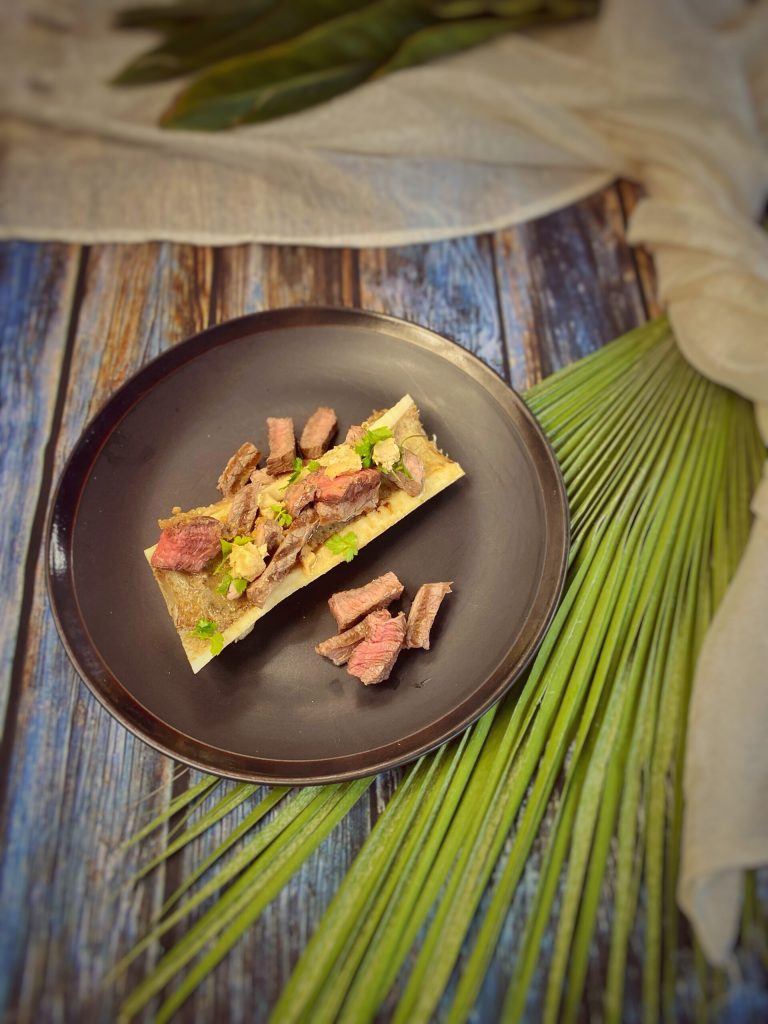Kilawin is a Filipino dish made with meat and vinegar, consisting of boiled and/or grilled meat, which can include goat, beef, chicken, pork, carabao (water buffalo) and deer, or a combination of these.
In contemporary times, the meats may be lightly cooked, typically grilled, before seasoning with vinegar.
The marinating process is known as kilaw (“cooking in acid”).
It is commonly associated with the Ilocano dish “kilawen a kalding” (Tagalog: kilawing kambing), which is lightly grilled goat meat traditionally eaten with papaít, or bile from a cow’s or goat’s gallbladder.
For Ilocanos, “kilawen” is the intransitive verb for the food preparation that includes all raw and lightly cooked or cured foods, including dishes that would be described as kinilaw (raw fish marinated in vinegar).
Pre-colonial Filipinos often ate their foods raw or rare.
Meats, including fish, were generally rinsed or seasoned in vinegar.
Later Pedro de San Buenaventura (chosen patron saint by some indigenous communities) chose the word “adobo” in the 16th century for kilaw, a mixture of salt, palm vinegar, and chili in which meat was marinated until tender.
My version, inspired by a MasterChef Australia recipe, is beef kilawin with marrow butter, presented on a baked beef femur and a sauce made with flavored butter.
Non-Ilocano Filipinos often refer to kilawin as meats cooked similarly to adobo or paksiw (a cooking style, slow-cooked in vinegar).

- Difficulty: Easy
- Cost: Medium
- Preparation time: 10 Minutes
- Portions: 2 People
- Cooking methods: Grill, Oven
- Cuisine: Filipino
- Seasonality: All seasons
Ingredients
- 2 beef femur bones (cut in half)
- 1.1 lbs beef
- 0.3 cups Sukang Iloko (Ilocano cane vinegar) (or wine vinegar)
- 1/2 onion
- 1 oz ginger
- 2 cloves garlic
- 4.4 oz butter
- to taste parsley
- to taste Salt and pepper
Steps
After soaking the femur for a couple of hours, season it with salt and pepper and bake it in the oven at 392°F for 20 minutes with the marrow facing upward.
Grill the whole beef with salt and pepper. Cut it into cubes and season it with vinegar.
Blend the onion with ginger and garlic. Cook the resulting paste in a pan and add the butter.
Serve the kilawin on the femur, and garnish with flavored butter and parsley.

FAQ
What are other dishes similar to Kilawin?
The term Ilocano kilawen is related to other similar origin dishes.
Filipino: “kilaw” (or “quilao”) and Hiligaynon “hilao,” meaning “to eat (raw),” also include relatives like: kinilaw, kilayen, kinilnat, kulao, kulawo, kelaguen.
Dinakdakan is made with various parts of pig head, red onions, siling haba or siling labuyo chilies, ginger, black peppercorns, calamansi juice, and bay leaves.
Insarabsab is similar to dinakdakan without pig brain.
Another Ilocano kilawin dish is known as ata-ata or kappukan, made with beef or carabao.
Among the Kapampangan people, kilawin uses fully cooked pork meat, heart, liver, and tripe.
A similar dish in Cavite uses fully boiled pig ears known as kulao or kilawin na tainga ng baboy, or tokwa’t baboy if mixed with fried tofu cubes.
Modern variations of this dish use soy sauce in addition to other ingredients.What is Sukang Iloko?
Sukang Iloko is a locally fermented cane sugar vinegar traditionally fermented in burnay jars.
It is dark, aromatic, and has the right blend of strength, acidity, and sweetness.
It stands out as one of the many products sought by those familiar with Vigan.
Its pronounced acidity gives the right touch to many favorite recipes and sauces.
It comes from local molasses (a byproduct of sugarcane) combined with various herbs and spices.

